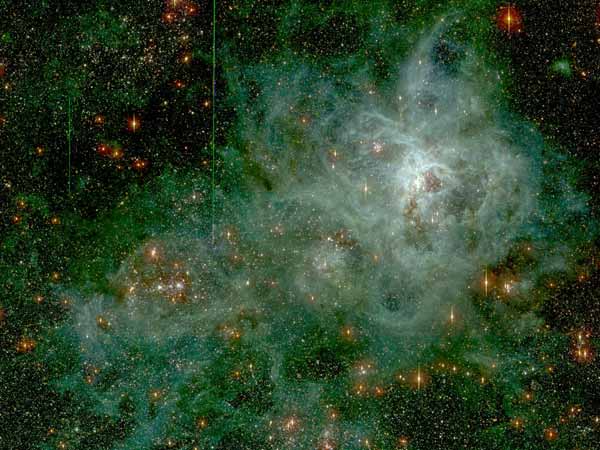Credit & Copyright: U. Michigan,
Lucent
Explanation:
30 Doradus is an immense star forming region in a nearby galaxy known
as the Large Magellanic Cloud.
Its
spidery appearance is responsible for its popular name, the
Tarantula Nebula, except that
this tarantula is about 1,000 light-years across, and
165,000 light-years away in the southern constellation
Dorado.
If it were at the distance of the
Orion Nebula,
the nearest stellar nursery to Earth, it
would appear to cover about 30 degrees
on the sky or about 60
full moons.
The
above image was taken with the
Big Throughput Camera
and is shown in representative colors.
The spindly arms of the
Tarantula Nebula surround the
NGC 2070 star cluster
which contains some of the intrinsically brightest,
most massive stars known.
This celestial
Tarantula is also seen near the site of the
closest recent Supernova.
1999 2000 2001 2002 2003 2004 2005 2006 2007 2008 2009 2010 2011 2012 2013 2014 2015 2016 2017 2018 2019 2020 2021 2022 2023 2024 2025 |
Январь Февраль Март Апрель Май Июнь Июль Август Сентябрь Октябрь Ноябрь Декабрь |
NASA Web Site Statements, Warnings, and Disclaimers
NASA Official: Jay Norris. Specific rights apply.
A service of: LHEA at NASA / GSFC
& Michigan Tech. U.
|
Публикации с ключевыми словами:
nebula - star cluster - LMC - Tarantula Nebula - 30 Doradus - звездное скопление - Области звездообразования - Большое Магелланово Облако - Туманность Тарантул
Публикации со словами: nebula - star cluster - LMC - Tarantula Nebula - 30 Doradus - звездное скопление - Области звездообразования - Большое Магелланово Облако - Туманность Тарантул | |
См. также:
Все публикации на ту же тему >> | |
